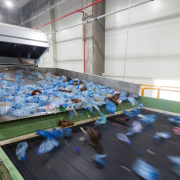Non-Ferrous Metals Division: Environmental Issues Are Global and so Require a Collective Solution
“Over the last two or three years, more and more countries have begun to look at raw material security,” observed BIR Non-Ferrous Metals Division President Dhawal Shah of India-based Metco Ventures LLP in addressing the body’s latest meeting, held in Amsterdam on May 22. However, he argued, sustainability and climate change were global issues and so “the solution will have to be found collectively”.
During her review of global trading conditions based on BIR’s latest World Mirror on Non-Ferrous Metals publication, Elinor Feuer of Sweden-based Chilanga AB echoed the concern over how policy interventions by governments were threatening free trade. She also lamented how global economic uncertainties were creating a reluctance among consumers to make purchases and among companies to invest, thereby leading to a reduced flow of material into scrap yards. However, she went on to praise the resilience of the recycling industry in facing up to such challenges in the past.
As well as his general industry observations, Mr Shah also focused on a draft standard in India covering domestic and imported aluminium and aluminium alloy scrap. This establishes six grades and identifies their individual purity/impurity thresholds, while also laying out potential sampling procedures. While the industry was still in discussions with the Indian government and further tweaks to the draft were possible, Mr Shah nevertheless anticipated implementation some time in 2023.
Guest speaker Jean-Marc Moulin, Head of Sustainability at Hydro Extrusions, explained that recycling was “at the core” of EU sustainability initiatives. Specific environmental goals at his own company included the development of a recycling value chain from sourcing to products and customers, and doubling its post-consumer aluminium scrap use by 2025.
Fellow guest speaker Jianbin Meng, Director of Economics and Environment at the International Lead and Zinc Study Group/International Nickel Study Group, provided an overview of the global lead and zinc industry and of scrap metals’ role in meeting demand needs. In 2022, he reported, secondary refined lead production accounted for 92% of the total refined metal production in the Americas and 83% in Europe, as compared to a figure of 55% for Asia which illustrated “a huge potential for growth”.
In the 62 years to 2022, cumulative refined lead usage had reached 422.1 million tonnes, of which 47% of the used metal was attributable to the recycling industry, the speaker continued.
Secondary zinc production was taking only a small share of total metal production “but a growth trend could be observed in recent years”, he added. In 2022, the share of secondary metal production reached 12.5% of the total as compared to only 6% in 2012.
In a subsequent panel discussion moderated by Natallia Zholud of TRM Group in Poland and Alejandro Jaramillo of Glorem SC in Mexico, Mr Meng confirmed that lead-acid batteries currently accounted for some 86% of the metal’s usage but that “economics and policy” would dictate the speed and extent to which demand for such batteries would decline. Notably, the cost of lithium batteries was falling and could even reach parity with lead-acid, he said.
Source: BIR (Amsterdam/Brussels, May 24, 2023)







